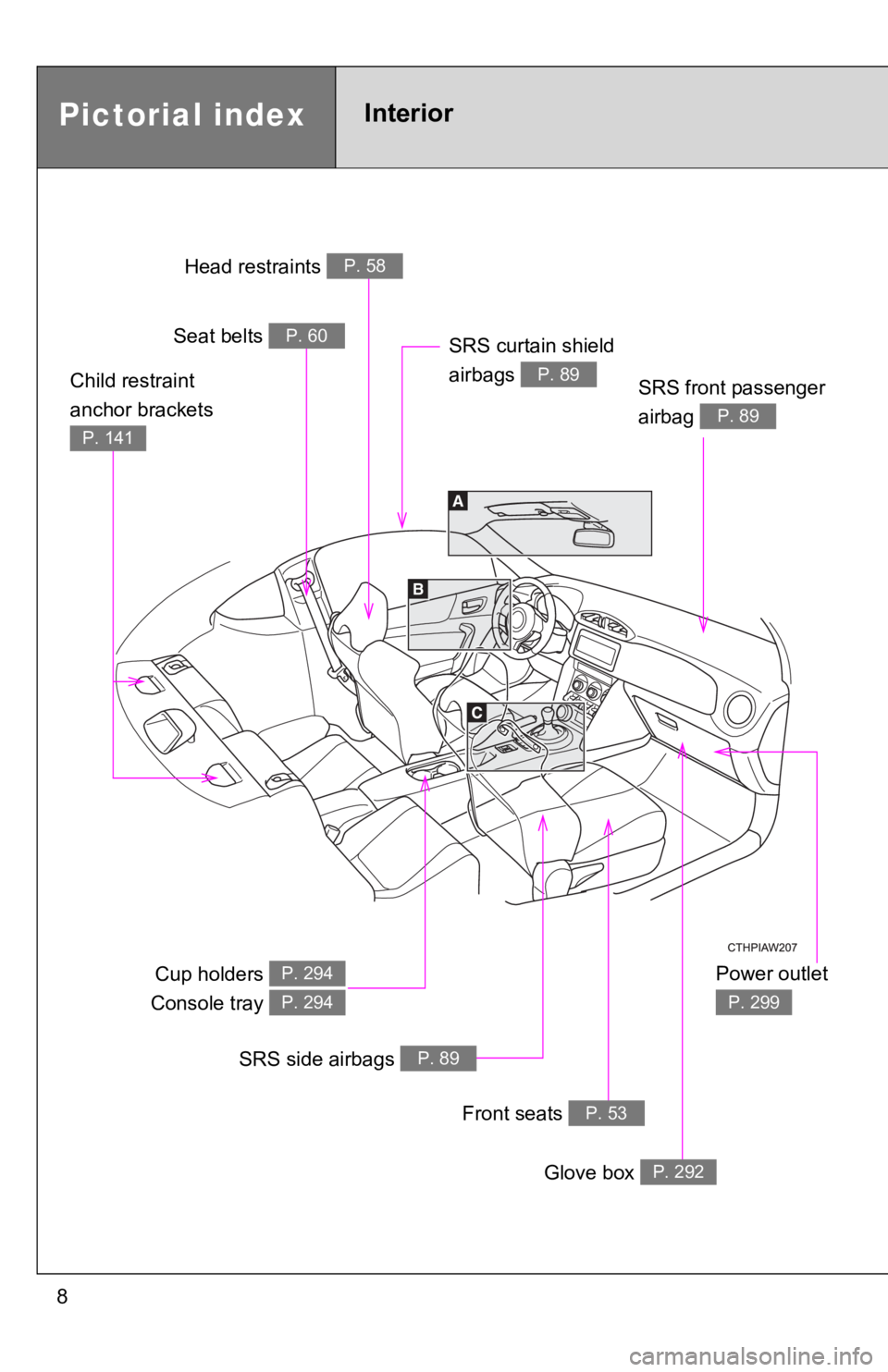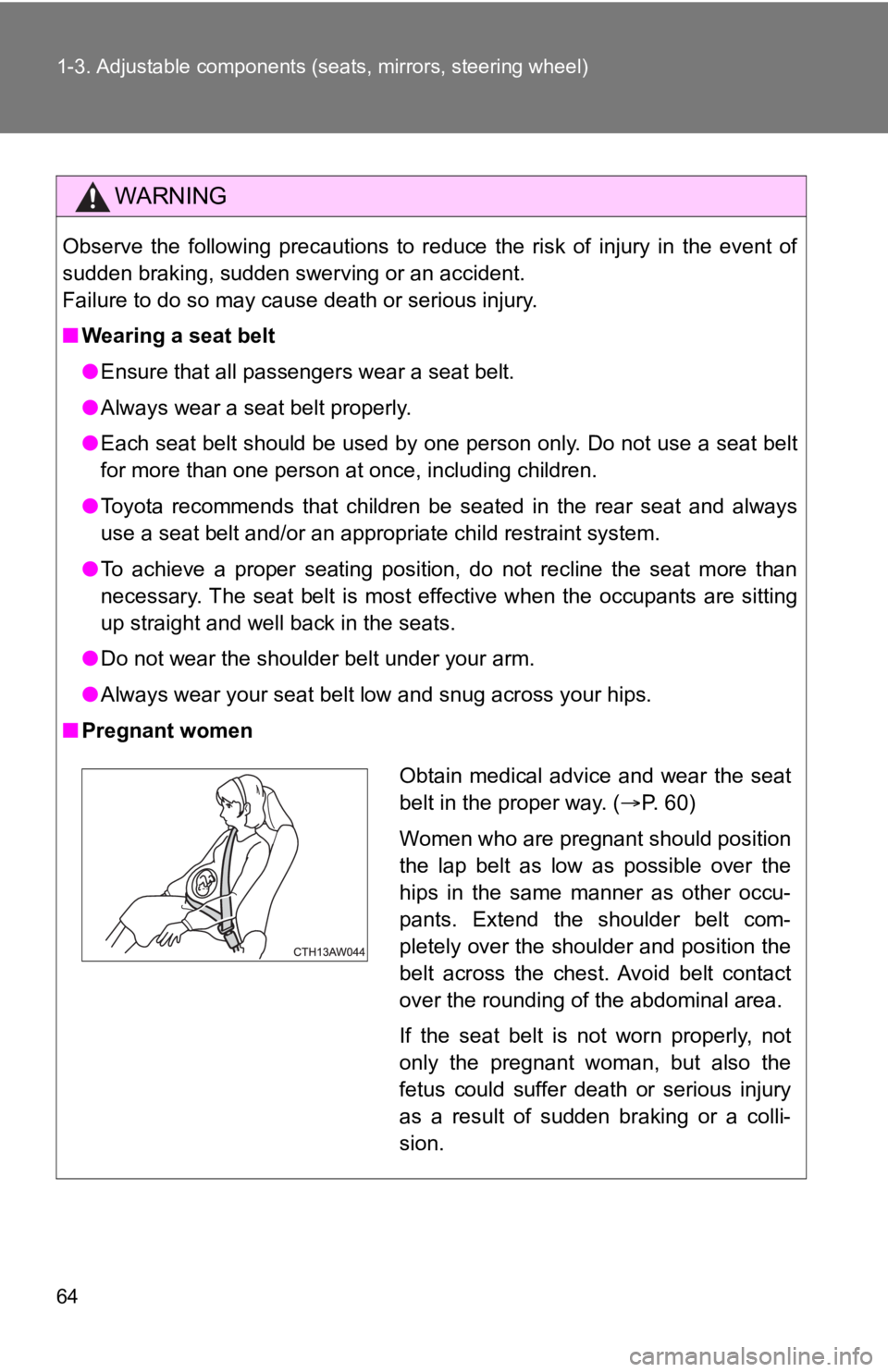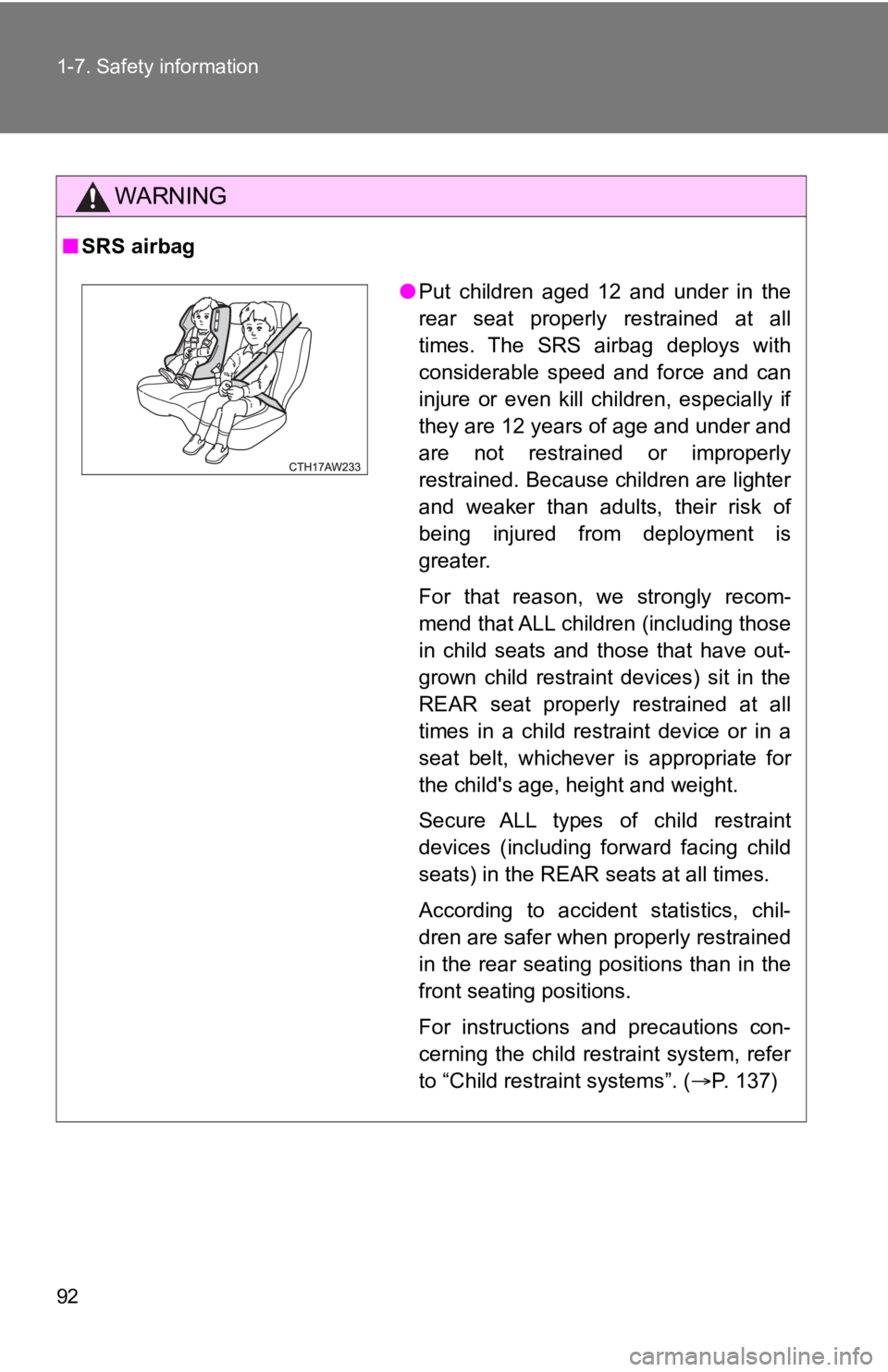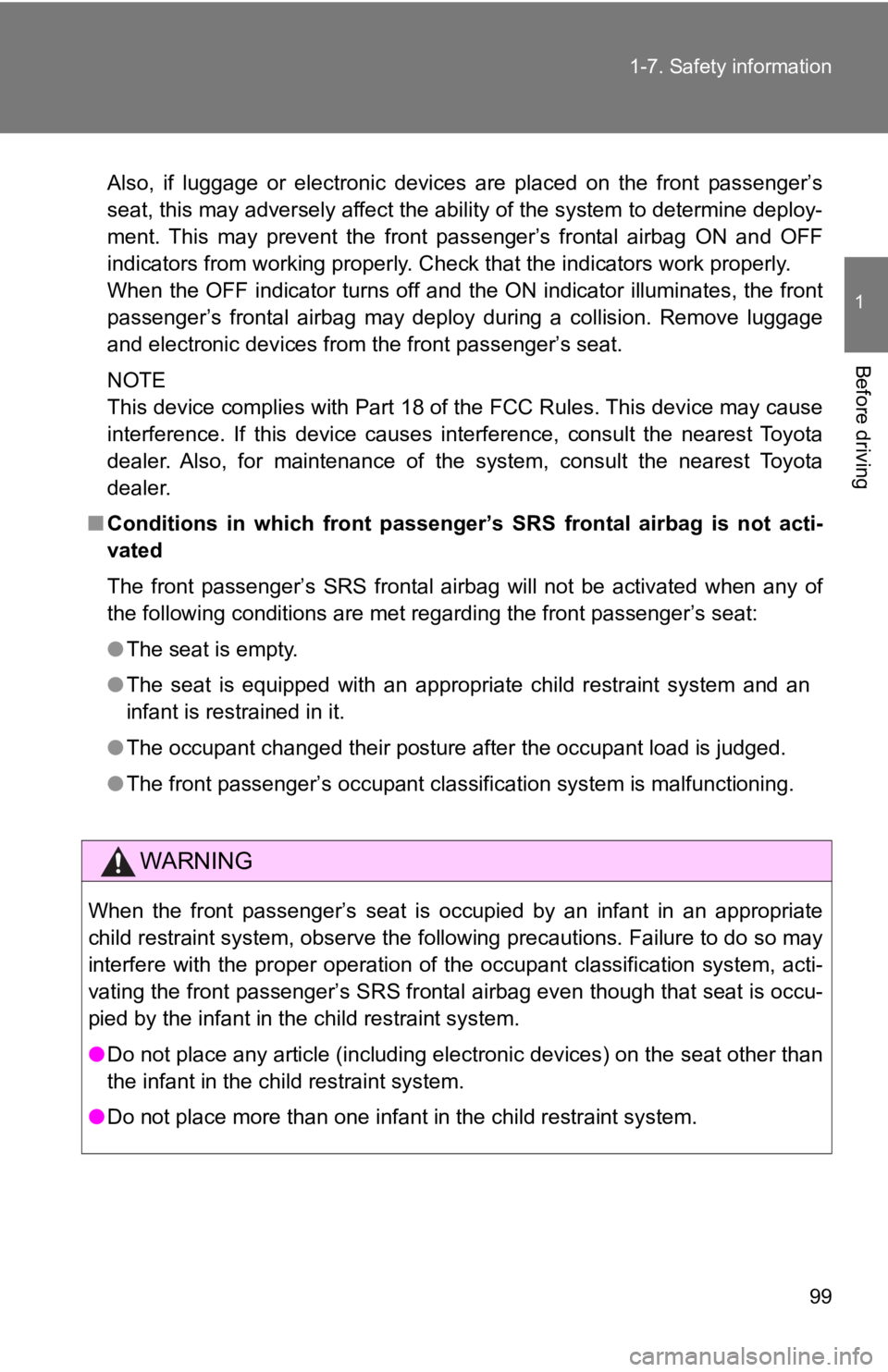2020 TOYOTA 86 child restraint
[x] Cancel search: child restraintPage 2 of 532

TABLE OF CONTENTSIndex
2
1-1. Key informationKeys ..................................... 22
1-2. Opening, closing and locking the doors and
trunk
Smart key system................. 25
Wireless remote control ....... 38
Doors.................................... 43
Trunk .................................... 46
1-3. Adjustable components (seats, mirrors,
steering wheel)
Front seats ........................... 53
Rear seats ............................ 56
Head restraints ..................... 58
Seat belts ............................. 60
Steering wheel ..................... 67
Anti-glare inside rear view mirror.......................... 68
Outside rear view mirrors ..... 69
1-4. Opening and closing the windows
Power windows .................... 72
1-5. Refueling Opening the fuel tank cap .... 75 1-6. Theft deterrent system
Engine immobilizer system ................................ 79
Alarm .................................... 82
Theft prevention labels (U.S.A.)............................... 86
1-7. Safety information Correct driving posture ......... 87
SRS airbag (Supplemental Restraint
System airbag) ................... 89
Front passenger occupant classification system ......... 128
Child restraint systems ....... 137
Installing child restraints ..... 141
2-1. Driving procedures Driving the vehicle .............. 152
Engine (ignition) switch (vehicles with a smart
key system) ...................... 166
Engine (ignition) switch (vehicles without a
smart key system) ............ 175
Automatic transmission ...... 178
Manual Transmission ......... 185
Turn signal lever ................. 188
Parking brake ..................... 189
Horn .................................... 190
1Before driving
2When driving
Page 8 of 532

8
Pictorial indexInterior
Power outlet
P. 299
Head restraints P. 58
Seat belts P. 60
SRS front passenger
airbag
P. 89
Cup holders
Console tray P. 294
P. 294
SRS side airbags P. 89
Front seats P. 53
Glove box P. 292
SRS curtain shield
airbags
P. 89Child restraint
anchor brackets
P. 141
Page 21 of 532

Before driving1
21
1-1. Key informationKeys ................................... 22
1-2. Opening, closing and locking the doors and
trunk
Smart key system .............. 25
Wireless remote control ..... 38
Doors ................................. 43
Trunk .................................. 46
1-3. Adjustable components (seats, mirrors,
steering wheel)
Front seats ......................... 53
Rear seats.......................... 56
Head restraints................... 58
Seat belts ........................... 60
Steering wheel ................... 67
Anti-glare inside rear view mirror ....................... 68
Outside rear view mirrors.............................. 69 1-4. Opening and closing
the windows
Power windows .................. 72
1-5. Refueling Opening the fuel tank cap ........................... 75
1-6. Theft deterrent system Engine immobilizer system ............................. 79
Alarm.................................. 82
Theft prevention labels (U.S.A.) ............................ 86
1-7. Safety information Correct driving posture....... 87
SRS airbag (Supplemental Restraint
System airbag)................. 89
Front passenger occupant classification system ...... 128
Child restraint systems..... 137
Installing child restraints... 141
Page 62 of 532

62 1-3. Adjustable components (seats, mirrors, steering wheel)
■Emergency locking retractor (ELR)
The retractor will lock the belt during a sudden stop or on imp act. It may also
lock if you lean forward too quickly. A slow, easy motion will allow the belt to
extend so that you can move around fully.
■ Automatic locking retractor (ALR)
When a passenger's shoulder belt is completely extended and the n
retracted even slightly, the belt is locked in that position and cannot be
extended. This feature is used to hold the child restraint syst em (CRS) firmly.
To free the belt again, fully retract the belt and then pull th e belt out once
more. ( P. 141)
■ Child seat belt usage
The seat belts of your vehicle are principally designed for persons of adult
size.
●Use a child restraint system appropriate for the child, until the child
becomes large enough to properly w ear the vehicle's seat belt.
( P. 137)
● When the child becomes large enough to properly wear the vehicl e's seat
belt, follow the instructions on P. 60 regarding seat belt usag e.
■ Seat belt pretensioners
●Seatbelt pretensioners are not designed to activate in a rear i mpact or
minor frontal or side impact.
● The following four components operate simultaneously when the v ehicle
is involved in a rollover accident.
• Seat belt pretensioner for driver
• Seat belt pretensioner for front passenger
• SRS curtain shield airbag for driver’s seat side
• SRS curtain shield airbag for front passenger’s seat side
Page 64 of 532

64 1-3. Adjustable components (seats, mirrors, steering wheel)
WARNING
Observe the following precautions to reduce the risk of injury in the event of
sudden braking, sudden swerving or an accident.
Failure to do so may cause death or serious injury.
■Wearing a seat belt
●Ensure that all passengers wear a seat belt.
● Always wear a seat belt properly.
● Each seat belt should be used by one person only. Do not use a seat belt
for more than one person at once, including children.
● Toyota recommends that children be seated in the rear seat and always
use a seat belt and/or an appropriate child restraint system.
● To achieve a proper seating position, do not recline the seat m ore than
necessary. The seat belt is most effective when the occupants a re sitting
up straight and well back in the seats.
● Do not wear the shoulder belt under your arm.
● Always wear your seat belt low and snug across your hips.
■ Pregnant women
Obtain medical advice and wear the seat
belt in the proper way. ( P. 60)
Women who are pregnant should position
the lap belt as low as possible over the
hips in the same manner as other occu-
pants. Extend the shoulder belt com-
pletely over the shoulder and position the
belt across the chest. Avoid belt contact
over the rounding of the abdominal area.
If the seat belt is not worn properly, not
only the pregnant woman, but also the
fetus could suffer death or serious injury
as a result of sudden braking or a colli-
sion.
Page 92 of 532

92 1-7. Safety information
WARNING
■SRS airbag
●Put children aged 12 and under in the
rear seat properly restrained at all
times. The SRS airbag deploys with
considerable speed and force and can
injure or even kill children, especially if
they are 12 years of age and under and
are not restrained or improperly
restrained. Because children are lighter
and weaker than adults, their risk of
being injured from deployment is
greater.
For that reason, we strongly recom-
mend that ALL children (including those
in child seats and those that have out-
grown child restraint devices) sit in the
REAR seat properly restrained at all
times in a child restraint device or in a
seat belt, whichever is appropriate for
the child's age, height and weight.
Secure ALL types of child restraint
devices (including forward facing child
seats) in the REAR seats at all times.
According to accident statistics, chil-
dren are safer when properly restrained
in the rear seating positions than in the
front seating positions.
For instructions and precautions con-
cerning the child restraint system, refer
to “Child restraint systems”. ( P. 137)
Page 99 of 532

99
1-7. Safety information
1
Before driving
Also, if luggage or electronic devices are placed on the front
passenger’s
seat, this may adversely affect the ability of the system to determine deploy-
ment. This may prevent the front passenger’s frontal airbag ON and OFF
indicators from working properly. Check that the indicators wor k properly.
When the OFF indicator turns off and the ON indicator illuminat es, the front
passenger’s frontal airbag may deploy during a collision. Remov e luggage
and electronic devices from the front passenger’s seat.
NOTE
This device complies with Part 18 of the FCC Rules. This device may cause
interference. If this device causes interference, consult the n earest Toyota
dealer. Also, for maintenance of the system, consult the neares t Toyota
dealer.
■ Conditions in which front passen ger’s SRS frontal airbag is not acti-
vated
The front passenger’s SRS frontal airbag will not be activated when any of
the following conditions are met regarding the front passenger’s seat:
● The seat is empty.
● The seat is equipped with an appropriate child restraint system and an
infant is restrained in it.
● The occupant changed their posture after the occupant load is j udged.
● The front passenger’s occupant classification system is malfunctioning.
WARNING
When the front passenger’s seat is occupied by an infant in an appropriate
child restraint system, observe the following precautions. Fail ure to do so may
interfere with the proper operation of the occupant classification system, acti-
vating the front passenger’s SRS frontal airbag even though tha t seat is occu-
pied by the infant in the child restraint system.
● Do not place any article (including electronic devices) on the seat other than
the infant in the child restraint system.
● Do not place more than one infant in the child restraint system.
Page 100 of 532

100 1-7. Safety information
■If the front passenger’s frontal a irbag ON indicator illuminates and the
OFF indicator turns off even when an infant or a small child is in a child
restraint system (incl uding booster seat)
Turn the engine switch to the “LOCK” position (vehicles without a smart key
system), or turn the “ENGINE START STOP” switch off (vehicles w ith a
smart key system) if the front passenger’s frontal airbag ON in dicator illumi-
nates and the OFF indicator turns off even when an infant or a small child is
in a child restraint system (including booster seat). Remove th e child
restraint system from the seat. By referring to the child restraint manufac-
turer’s recommendations as well as the child restraint system installation
procedures in “Child restraint systems” ( P. 137), correctly install the child
restraint system. Turn the engine switch to the “ON” position ( vehicles with-
out a smart key system), or turn the “ENGINE START STOP” switch to IGNI-
TION ON mode (vehicles with a smart key system) and make sure that the
front passenger’s frontal airbag ON indicator turns off and the OFF indicator
illuminates.
If still the ON indicator remains illuminated while the OFF ind icator turns off,
take the following actions.
● Ensure that no article is placed on the seat other than the chi ld restraint
system and the child occupant.
● Ensure that the backward-forward position and seatback of front passen-
ger’s seat are locked into place securely by moving the seat back and
forth.
If the ON indicator still remains illuminated while the OFF indicator turns off
after taking relevant corrective actions described above, reloc ate the child
restraint system to the rear seat and immediately contact your Toyota dealer
for an inspection.
NOTE
When a child who has outgrown a child restraint system or a sma ll adult is
seated in the front passenger’s seat, the Toyota advanced front al airbag sys-
tem may or may not activate the front passenger’s SRS frontal a irbag
depending on the occupant’s seating posture. The child should a lways wear
the seat belt when sitting in the seat irrespective of whether the airbag is
deactivated or activated. If the front passenger’s SRS frontal airbag is acti-
vated (the ON indicator remains illuminated while the OFF indic ator turns
off), take the following actions.